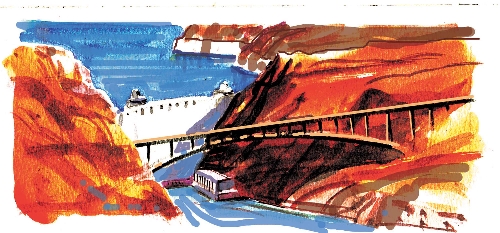Hoover Dam remains engineering marvel

Hoover Dam commands attention, still ranking as one of world’s engineering marvels 77 years after its dedication.
The landmark annually draws nearly a million visitors from around the world, and Southern Nevadans may find themselves in the minority at the dam, despite its location just 30 miles from Las Vegas.
The huge steel-and-concrete structure sits wedged between the high, sheer cliffs of Black Canyon like half of a broken teacup, frail looking despite its mighty size. It backs up the waters of the Colorado River into Lake Mead, one of the world’s largest reservoirs. The dam harnesses the river’s force to supply electrical power to many Western cities. It stores the river’s flow to irrigate rich agricultural areas and to supply drinking water to millions.
Its construction during the dark days of the Great Depression changed the face of the desert and the course of this area’s history more than any other modern accomplishment.
Since the 2010 opening of the U.S. Highway 93 bypass bridge across the Colorado River just south of the dam, the approach to Hoover Dam is somewhat different. Follow U.S. 93 from Las Vegas to Boulder City, turning left at Buchanan Boulevard to skirt the historic core of town. Continue on the highway with its beautiful views of Lake Mead. About five miles past the Hacienda Hotel, former U.S. 93 becomes Nevada Route 172, the Hoover Dam access road. The dam is about two miles beyond the junction. The narrow road still crosses the top of the dam to reach parking on the Arizona side.
To continue on U.S. 93, dam visitors must retrace the route on the dam access road back to the junction. Through traffic on U.S. 93 between Nevada and Arizona uses a new section of highway to reach the bridge across the river. The handsome span sits south of the dam about 900 feet above the water. Designed to prevent distracted driving, the sides of the bridge are too high for drivers to see the dam. In order to enjoy this spectacular view of the dam, you must pull off the highway into a designated viewing area.
Tours of Hoover Dam began in 1937 and were an immediate success. The dam remains open in daytime all year except for Thanksgiving and Christmas. The weeks between Memorial Day and Labor Day draw the dam’s largest crowds despite ferocious heat. January and February draw the fewest visitors.
This time of year, the parking garage near the visitor center with nearly 500 spaces opens at 8 a.m. The visitor center opens at 9 a.m. By 10:30 a.m., traffic gets heavier. To avoid congestion, plan your visit to the dam early in the day during the cooler months of the year on a weekday, if possible.
Located close to exhibit areas, tour assembly points, food concessions and other facilities, the parking garage is the best bet for regular vehicles. Oversized vehicles must park across the dam, and visitors must walk some distance down to the dam and back across it to the visitor center on the Nevada side. Parking costs $7. A couple of lots offer free parking, but the hike is longer.
Options for tours include a tour of the visitor center itself, a half-hour tour of the dam’s power plant including the visitor center, or an hourlong Hoover Dam guided tour including the visitor center and power plant, which is limited to 20 people ages 8 and older and is not wheelchair accessible. Tickets for the visitor center and powerhouse tours are available online. Tickets for the longer Hoover Dam tour are available only at the dam and frequently sell out early.
Federal recreation passes do not apply at Hoover Dam. The visitor center tour costs $8 and is free for children younger than 4. Power plant tours cost $11 for adults older than 16 and $9 for seniors 62 and older, children 4 to 16 and military personnel not in uniform (those in uniform tour free of charge). The Hoover Dam tour costs $30 for everyone.
Claustrophobic visitors will not enjoy the guided tour’s close spaces. Anyone wearing a pacemaker or defibrillator should avoid the tours involving the powerhouse, which fairly hums with the power being generated there.
Margo Bartlett Pesek’s column appears on Sundays.